Friends who are familiar with NVMe know that the concept of namespace in NVMe is to divide the SSD physical space into several logical address spaces. In the UFS world, it also has this feature. The physical storage space of a UFS device can have a number of independent logical address spaces. We call the logical address space an LU, that is, a Logical Unit, commonly known as “撸â€. As we saw earlier, in each UPIU header, there is a LUN (Logical Unit Number) field, which is a target logical unit that identifies the UPIU associated command or request. The address space of each LU is independent. When the host sends commands or requests to the device, it must specify the target logical unit through the LUN.
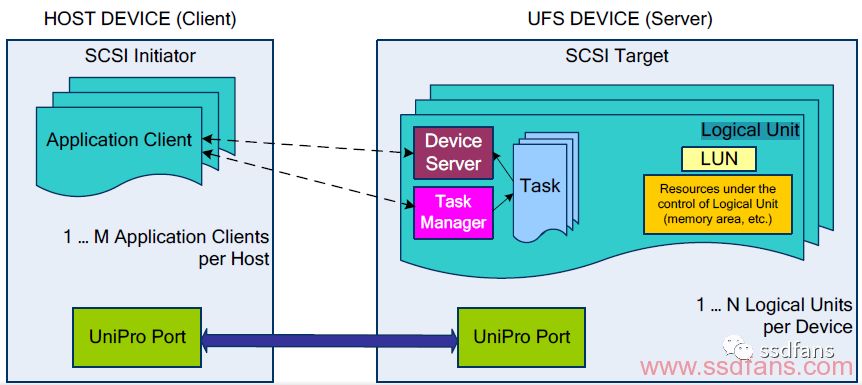
As shown in the above figure, the UFS device has several LUs. Each LU receives commands or requests from the host. These commands or requests can come from the application layer SCSI module, device manager, or task manager. Each LU is independent, "independent" in the following areas:
Logical address space is independent, starting from LBA 0;
Logical block size can be different, can be 4KB,..;
Can have different security attributes, for example, you can set different write protection attributes;
Each LU can have its own command queue;
Different LUs can store different data, such as some LU storage system startup code, some LUs store common application data, and some LUs store user-specific data...
. . .
There can be up to 32 ordinary LUs and "Four Famous LUs" (four well known LUs) in UFS2.1.
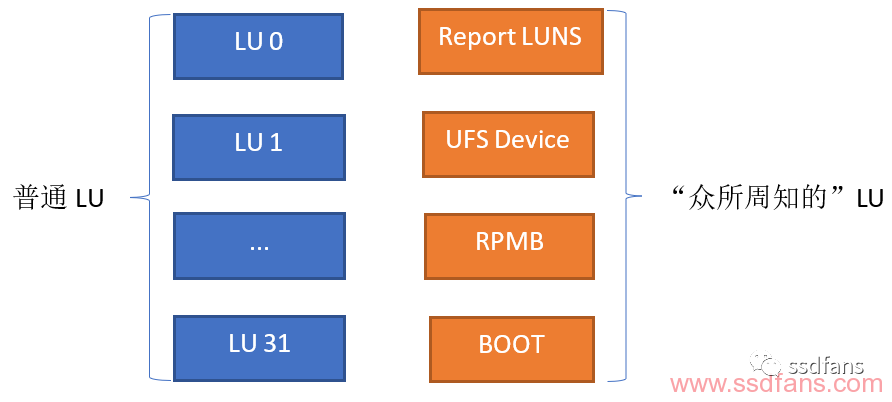
The logical block size of a normal LU is at least 4KB, but the RPMB LU logical block size is 256B. As for what is RPMB LU, I will talk about it later.
Ordinary LU, I think there is nothing to talk about, is used to store user data. We mainly talk about the "four famous names."
Report LUNS LU
Report LUNS is mainly used to represent the device to report the device LU list to the host. If the host wants to know the support of the device LU, it needs to send a command or request it to the LU. UFS has a command “Report LUNS†(same name as the LU) used to access Report LUNS.

UFS Device LU
UFS equipment legal person. When the UFS host does not target a specific LU but sends commands to the entire UFS device, the UFS Device LU becomes the object that the command receives, such as formatting the UFS device (FORMAT UNIT command) and switching the power consumption mode of the UFS device. (START STOP UNIT command) and so on.
BOOT LU
As the name implies, it is the LU that stores startup code. However, the Boot ROM itself does not store boot code. It is just a virtual LU. The boot code is physically stored on a regular LU.
There are two Boot LUs, LU A and LU B, which can be used to store different startup codes (such as a new one, an old one), but only one is active during the startup process. Any one of 32 ordinary LUs can be configured as Boot LU A or Boot LU B.
for example:
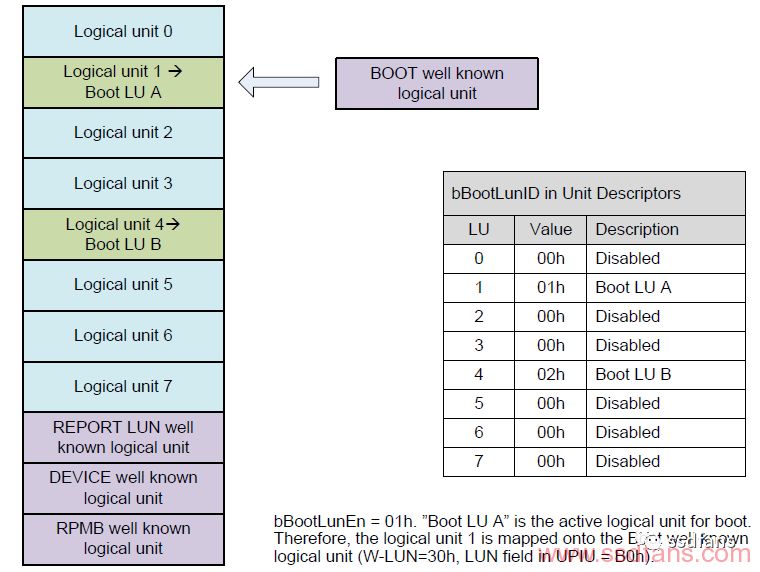
In the above example, LU 1 acts as Boot LU A and LU 4 acts as Boot LU B. Since there are two startup codes stored separately in LU 1 and LU 4, which one is read at startup?
When the host starts, it should first send a Query request to the device through the device manager to obtain an attribute called "bBootLunEn". This attribute identifies the currently active Boot LU.
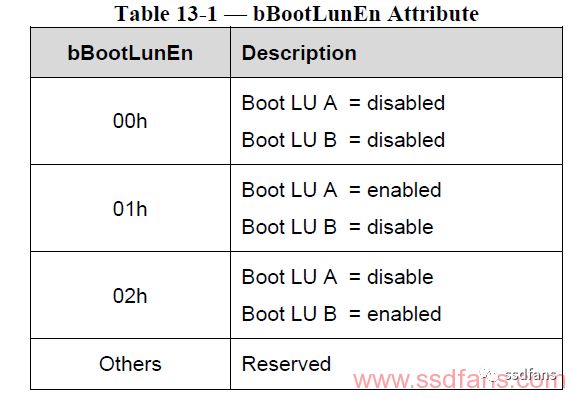
In the above example, bBootLunEn = 01, indicating that Boot LU A is the currently active Boot LU, so the host will read the boot code from LU 1 to complete the system startup.
It is worth mentioning that Boot LU is not required. If the boot code of the system is not stored on the UFS device, the Boot LU is not needed, so bBootLunEn = 0.
RPMB LU
In UFS, there is such a LU, when the host writes data to the LU, the UFS device will check the validity of the data, only the specific host can write; At the same time, the host also provides a verification mechanism when reading data. It ensures that the data read by the host is data read from the LU, not the data forged by the attacker. This LU is RPMB LU.
About RPMB, there are special chapters behind the introduction, not much to say here.
“Four famous names†Each LU has a clear division of labor and performs different tasks. Here's a list of the commands that can be accepted by the "four big names":
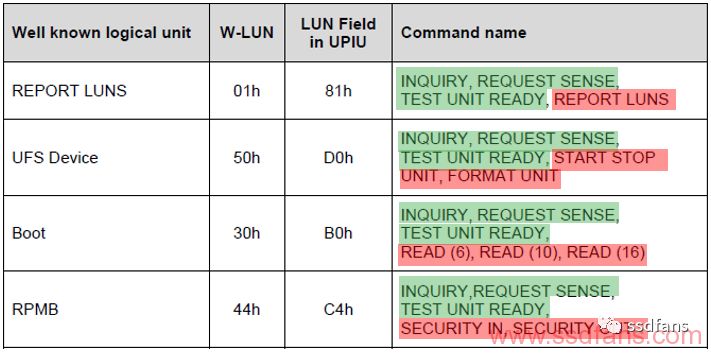
They can receive some common commands (green commands as shown above), and only commands that the LU can execute (such as red commands). Specific commands can be viewed by Spec.
It should be noted that when writing Boot LU and RPMB LUs, it does not support the cache operation. That is, after the data must be written to the flash memory, the write command is completed. The write to the general LU is generally a cache operation, that is, the host data to the device's internal buffer, the device will return the command to the host to complete the state.
Could you share which points you care more when choose a teacher laptop? Size, cpu, storage, memory, battery, screen, fingerprint or backlight? As one of the top laptops for teachers in 2022, this 15.6 inch celeron N5095 or J4125 online teaching laptop is of the special necessary features a laptop for online teaching has. For example, high quality 1080P screen, bigger battery, updated storage and memory, mid-level cpu, etc. So many clients choose this model as laptop for teachers malaysia or laptops for teachers program.
Of course, there are other type Education Laptop, like 14 inch windows 10 64 gb Student Laptop, 15 inch 10th good laptops for university students, 16.1 inch i7 9th hq 4gb video graphic laptop, etc.
If you have other type device interest, just let us know since we also customize android or windows tablet, Mini PC and All In One PC.
Believe always have a right one meeting your special demand, no matter for student project, business tender, academic institution or reselling.
Teacher Laptop,Online Teaching Laptop,Top Laptops For Teachers,Laptop For Teachers Malaysia,Laptops For Teachers Program
Henan Shuyi Electronics Co., Ltd. , https://www.sycustomelectronics.com